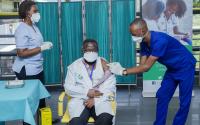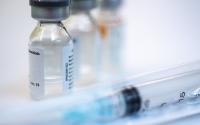[ad_1]
Table of Contents
Exposure to misinformation leads to decline in COVID-19 uptake intent
A randomized control trial shows that being exposed to misinformation about the COVID-19 vaccine induced a decline in the intent to definitely get the COVID vaccine of 6.2 percentage points in the United Kingdom and 6.4 percentage points in the United States, according to a study today in Nature Human Behaviour.
Various models show a COVID-19 vaccine will need to be accepted by at least 55% of a country’s population to provide herd immunity, with estimates reaching as high as 85%, depending on country and infection rates, the authors wrote. Rampant misinformation on social media concerning the novel COVID vaccines could hinder the road to herd immunity.
In this study, 8,000 participants completed questionnaires before and after being exposed to five images that contained vaccine misinformation. The main question was if the respondent would get a vaccine if it became available. Respondents were also asked about their social media use, and about sources they trust for vaccine information.
Before exposure to misinformation 54.1% of respondents in the United Kingdom and 42.5% in the United States reported that they would definitely accept a COVID-19 vaccine to protect themselves. Those percentages dropped by 6.2 points and 6.4 points, respectively, after misinformation exposure.
Female participants were less likely than male participants to be affected by misinformation, whereas lower socioeconomic status was associated with more susceptibility. Respondents were also most receptive to misinformation that claimed to be based in scientific fact.
“We find correlational evidence that misinformation identified by our participants after exposure as having the most impact on lowering their vaccination intent was made to have a scientific appeal, such as emphasizing on a direct link between a COVID-19 vaccine and adverse effects while using scientific imagery or links to strengthen their claims,” the authors concluded.
Feb 5 Nat Hum Behav study
Small study finds colchicine improves outcomes in COVID-19 patients
Colchicine appeared to be safe and effective in treating moderate to severe COVID-19 infections in hospitalized patients, according to a randomized, double-blind clinical trial published yesterday in RMD Open.
Patients who took the inexpensive drug, which is commonly used to treat gout, required supplemental oxygen and hospitalization for less time.
From Apr 11 to Aug 30, 2020, 72 Brazilian patients received either a placebo or 0.5 milligrams of colchicine three times a day for 5 days followed by the same dose twice a day for 5 days in addition to a standard COVID-19 treatment of azithromycin, hydroxychloroquine, heparin, and (after the RECOVERY Collaborative Group results were announced) glucocorticoid. Methylprednisolone was given if supplemental oxygen was 6 liters per minute or higher.
The most common side effect was diarrhea (16.7%), and colchicine doses were adapted if the patient weighed at least 176 pounds (80 kilograms) or had chronic kidney disease.
Those on colchicine needed oxygen for an average of 4 days and stayed in the hospital for an average of 7 days; whereas, the control group needed oxygen for 6.5 days and stayed 9 days. The drug’s effect on ICU admission or mortality rate was not able to be quantified, although the researchers note that 1 patient in the colchicine group went to the ICU compared with 3 in the placebo group. The only deaths occurred in two male patients in the placebo group.
While the researchers acknowledge these results aren’t generalizable (34 of 35 patients receiving colchicine were overweight or obese), they say colchicine’s ability to slow systemic inflammation is promising. “Whatever the mechanism of action … colchicine seems to be beneficial for the treatment of hospitalised patients with COVID-19,” they write.
In a Washington Post editorial today, Ezekiel Emanuel, MD, PhD, and colleagues mention a previous Canadian study suggesting that colchicine reduced hospitalizations by 25%. COVID-19 vaccines are great, they write, but the United States also needs to improve genomic surveillance, create multivalent (multi-strain) vaccines, and most important, focus more on scalable treatments.
Feb 4 RMD Open study
Feb 5, Washington Post op-ed
Physical distancing tied to lower individual COVID-19 risk
People who maintained better physical distancing were less likely to be infected by SARS-CoV-2, the virus that causes COVID-19, reports a study published yesterday in Proceedings of the National Academy of Sciences. The study also found that in-the-moment virtual scenarios were better at assessing participants’ physical distancing adherence than survey questions were.
In May and June 2020, 2,120 people answered a survey about how well they followed physical (social) distancing guidelines and then completed 10 virtual scenarios that, for example, showed how they would walk through a crowded plaza, where they would place their towel at a beach, or where they would stand in line.
Four months later, 199 of the 1,885 people that did not have COVID-19 prior to the study reported suspected or confirmed infections (10.6%). Out of all the participants, the most common causes people listed were household members (23.3%), work (21.9%), and indoor settings such as a restaurant or church (17.6%).
The most accurate predictor of infection was not the survey, which skewed toward the positive end of adherence, but the virtual scenarios, which had a more normal distribution curve. “An increase of one SD [standard deviation] on the virtual behavior measure of social distancing was associated with roughly a 20% reduction in the odds of contracting COVID-19,” the researchers write, adding that the finding holds true when looking at all possible COVID cases or solely those confirmed by diagnostic tests.
“The evidence from our work indicates there is value in socially distancing—not only to reduce the spread of a virus within a community, but because it is actually beneficial for the individual engaging in the social distancing,” adds Russell Fazio, PhD, senior study author, in an Ohio State University press release.
Feb 4 Proc Natl Acad Sci study
Feb 4 Ohio State press release
[ad_2]
Source link












